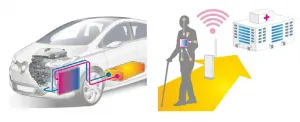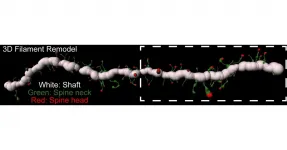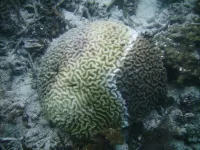Beauty in imperfection: How crystal defects can help convert waste heat into electricity
Scientists clarify how crystal defects in Ni-based alloys give rise to high thermoelectric conversion efficiencies, advancing thermoelectric technology
2021-01-26
(Press-News.org) If we are to prevent the impending environmental crisis, it is imperative that we find efficient and sustainable ways to avoid being wasteful. One area with much room for improvement is the recycling of waste heat from industrial processes and technological devices into electricity. Thermoelectric materials are at the core of research in this field because they allow for clean power generation at little cost.
For thermoelectric materials to be used in vastly different fields such as steel works and transportation, they need to be able to operate in both high and low temperature regimes. In this regard, "half-Heusler Ni-based alloys" are currently under the spotlight thanks to their attractive thermoelectric efficiency, mechanical strength, and durability. Though much effort has been devoted to understanding and improving upon these peculiar alloys, scientists have found it difficult to clarify why half-Heusler Ni-based alloys have such a high conversion efficiency. Some have theorized that defects in the material's crystal structure increase its thermal conductivity and, in turn, its conversion efficiency. However, the crystal structure around the defects is unknown and so are their specific contributions.
In a recent study published in Scientific Reports, a team of scientists from Japan and Turkey, led by Associate Professor Hidetoshi Miyazaki from Nagoya Institute of Technology, Japan, have now attempted to make this issue crystal clear! Their research combined theoretical and experimental analyses in the form of large-scale crystal structure simulations and X?ray absorption fine structure (XAFS) spectra on NiZrSn alloys.
Using these techniques, the team first calculated the structural effects that an additional Ni atom (defect) would have in the arrangement of NiZrSn crystals. Then, they verified the theoretical predictions through different types of XAFS measurements, as Dr. Miyazaki explains, "In our theoretical framework, we assumed crystal lattice distortions to be a consequence of atomic defects to perform first-principles band structure calculations. XAFS made it possible to obtain detailed information on the local crystal structure around atomic defects by comparing the experimental and theoretical spectra of the crystal structure." These observations allowed the scientists to accurately quantify the strain that Ni defects cause in nearby atoms. They also analyzed the mechanisms by which these alterations give rise to a higher thermal conductivity (and conversion efficiency).
The results of this study will be crucial in advancing thermoelectric technology, as Dr. Miyazaki remarks: "We expect that our results will contribute to the development of a strategy centered around controlling the strain around defective atoms, which in turn will allow us to engineer new and better thermoelectric materials." Hopefully, this will lead to a leap in thermoelectric conversion technology and hasten the transition to a less wasteful, decarbonized society--one in which excess heat is not simply discarded but instead recovered as an energy source.
On a final note, Dr. Miyazaki highlights that the techniques used to observe fine changes in strain in crystalline structures can be readily adapted to other types of material, such as those intended for spintronic applications and catalysts.
There is certainly much to gain from going after the fine details in materials science, and we can rest assured that this study marks a step in the right direction toward a better future!
INFORMATION:
[Attachments] See images for this press release:

ELSE PRESS RELEASES FROM THIS DATE:
2021-01-26
VANCOUVER, Wash. -When entrepreneurs dream up ideas for new businesses, cannabis use might help, and hinder, their creativity, according to a new study in the Journal of Business Venturing by Washington State University researchers.
The study found that cannabis-using entrepreneurs generated new business ideas such as a weightless, gravity-free virtual reality workout, that were more original, but less feasible, compared to those who do not use cannabis.
"Originality and feasibility are both crucial in entrepreneurship--one without the other limits potential value creation," said Benjamin Warnick, lead author of the study and assistant professor in the ...
2021-01-26
LONDON, ON - Neurofeedback, also called 'brain training,' consists of exercises where individuals regulate their own brain activity. In a new study from Lawson Health Research Institute and Western University, researchers have found that neurofeedback may be an effective treatment for individuals with post-traumatic stress disorder (PTSD). Published in END ...
2021-01-26
A new study found that talented dogs can learn new words after hearing them only four times.
While preliminary evidence seems to show that most dogs do not learn words (i.e. names of objects), unless eventually very extensively trained, a few individuals have shown some exceptional abilities.
The Family Dog Project research team at the Department of Ethology, Eötvös Loránd University, Budapest is investigating on these exceptionally talented dogs who seem to learn words in the absence of any formal training, but simply by being exposed to playing with their owners in the typical way ...
2021-01-26
Toddlers with high daily touchscreen use are quicker to look at objects when they appear and are less able to resist distraction compared to toddlers with no or low touchscreen use - according to new research from Birkbeck, University of London, King's College London and University of Bath.
The research team say the findings are important for the growing debate around the role of screen time on toddlers' development especially given the increased levels of screen time seen during the COVID-19 pandemic.
Lead researcher Professor Tim Smith, from Birkbeck's ...
2021-01-26
New research from Queen Mary University of London and the University of Maryland, has reignited the debate around the behaviour of the giant dinosaur Spinosaurus.
Since its discovery in 1915, the biology and behaviour of the enormous Spinosaurus has puzzled palaeontologists worldwide. It was recently argued that the dinosaur was largely an aquatic predator, using its large tail to swim and actively pursue fish in the water.
The new study, published today in Palaeontologia Electronica, challenges this recent view of Spinosaurus suggesting that whilst it likely fed ...
2021-01-26
Philadelphia, January 26, 2021 - Addiction, or substance use disorder (SUD), is a complex neurological condition that includes drug-seeking behavior among other cognitive, emotional and behavioral features. Synaptic plasticity, or changes in the way neurons communicate with one another, drives these addictive behaviors. These lasting brain changes are at the crux of why addiction is so hard to treat.
A new study in Biological Psychiatry, published by Elsevier, now shows that players in the extracellular environment - not just at neuronal interfaces - contribute to addiction plasticity. Neurons in a brain area called the nucleus accumbens are known to undergo addiction-related plasticity. Specifically, changes at synapses of medium spiny neurons (MSN), which sense the ...
2021-01-26
By 2020, massive losses of large populations of corals have been observed throughout Florida and into the greater Caribbean basin. Taking into account the high mortality and the large number of susceptible species affected, this is likely the most lethal case of Stony Coral Tissue Loss Disease (SCTLD) ever recorded in modern history.
However, for too long, the tremendous decline in coral reefs has wrongly been attributed to the local dredge project, which had been ongoing at the time of the initial reports. In a recent Perspectives paper, END ...
2021-01-26
Philadelphia, January 26, 2021 - Researchers at Children's Hospital of Philadelphia (CHOP) and the University of Pennsylvania found female and male collegiate athletes take approximately the same amount of time to recover from a concussion, with subtle differences in recovery time depending on the type of sports being played and the division level of the sport. The findings suggest that equity in access to sports medical care among college athletes may be contributing to these similar outcomes.
The findings, derived as part of the CARE (Concussion Assessment, Research and Education) Consortium, ...
2021-01-26
New research coming out of UBC's Okanagan campus may take the current 'gold standard' for heart valves to a new level of reliability.
A team of researchers at UBCO's Heart Valve Performance Lab (HVPL) has developed a way to improve overall blood flow through the valves, so the design of mechanical heart valves will more closely match the real thing.
"Despite more than 40 years of research, we are still chasing the goal of creating mechanical heart valves that perform consistently and seamlessly inside the human body," explains Dr. Hadi Mohammadi, an associate professor ...
2021-01-26
Researchers with the Fatty Acid Research Institute (FARI) and collaborators at Cedars-Sinai Medical Center in Los Angeles and in Orange County, CA, have published the first direct evidence that higher omega-3 blood levels may reduce risk for death from COVID-19 infection. The report was published in the journal Prostaglandins, Leukotrienes and Essential Fatty Acids on January 20, 2021.
There are several papers in the medical literature hypothesizing that omega-3 fatty acids should have beneficial effects in patients with COVID-19 infection, but up until now, there have been no published peer-reviewed studies supporting that hypothesis.
This study included ...
LAST 30 PRESS RELEASES:
[Press-News.org] Beauty in imperfection: How crystal defects can help convert waste heat into electricity
Scientists clarify how crystal defects in Ni-based alloys give rise to high thermoelectric conversion efficiencies, advancing thermoelectric technology




